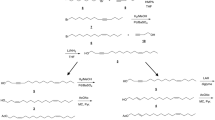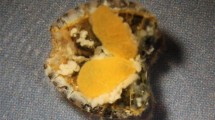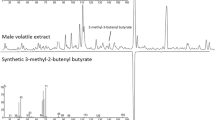Abstract
The attraction of nymphs of the ticksAmblyomma hebraeum andA. variegatum to CO2 alone and CO2 together with the male-produced aggregation-attachment pheromone (AAP) was investigated. Matching experiments on the attraction of the adults of the two species were run for comparison. Nymphs ofA. hebraeum were strongly attracted to sources of CO2 and CO2/AAP at distances of 10 and 15 m. At distances of 20 and 25 m significantly more nymphs were attracted to CO2/AAP than to CO2 alone. Adults ofA. hebraeum were not attracted to CO2 alone at any distance; these ticks were attracted to CO2 and AAP together for distances of up to 25 m. The patterns of attraction of nymphs and adults ofA. variegatum at 10 m were similar to those recorded inA. hebraeum.
Similar content being viewed by others
References
Horak, I.G., MacIvor, K.M. De F., Petney, T.N. and de Vos, V., 1987. Some avian and mammalian hosts ofAmblyomma hebraeum andAmblyomma marmoreum (Acari: Ixodidae). Onderstepoort J. Vet. Res., 54: 397–403.
Matthysse, J.G. and Colbo, M.H., 1987. The Ixodid Ticks of Uganda. Entomol. Soc. Am., College Park, MD, 426 pp.
Norval, R.A.I., 1974. Studies on the biology and ecology ofAmblyomma hebraeum Koch, 1844 and other tick species (Ixodidae) of the Eastern Cape. Ph.D. thesis, Rhodes University, Grahamstown, South Africa, 164 pp.
Norval, R.A.I., 1983. The ticks of Zimbabwe. VII. The genusAmblyomma. Zimb. Vet. J., 14: 3–18.
Norval, R.A.I. and Lawrence, J.A., 1979. The control of heartwater in Zimbabwe Rhodesia. Zimb. Rhod. Agric. J., 76: 161–166.
Norval, R.A.I., Yunker, C.E. and Butler, J.F., 1987. Field sampling of unfed adults ofAmblyomma hebraeum Koch. Exp. Appl. Acarol., 3: 213–217.
Norval, R.A.I., Yunker, C. E., Gibson, J.D. and Deem, S.L.D., 1988. Field sampling of unfed nymphs ofAmblyomma hebraeum. Exp. Appl. Acarol., 4: 173–177.
Norval, R.A.I., Andrew, H.R. and Yunker, C.E., 1989a. Pheromone-mediation of host-selection in bont ticks (Amblyomma hebraeum Koch). Science, 243: 364–365.
Norval, R.A.I., Butler, J.F. and Yunker, C.E., 1989b. Use of carbon dioxide and natural or synthetic aggregation-attachment pheromone of the bont tick,Amblyomma hebraeum, to attract and trap unfed adults in the field. Exp. Appl. Acarol., 7: 171–180.
Norval, R.A.I., Andrew, H.R. and Yunker, C.E., 1990. Infection rates withCowdria ruminantium of nymphs and adults of the bont tickAmblyomma hebraeum collected in the field in Zimbabwe. Vet. Parasitol., 36: 277–283.
Norval, R.A.I., Peter, T., Yunker, C.E., Sonenshine, D.E. and Burridge, M.J., 1991a. Responses of the ticksAmblyomma hebraeum andA. variegatum to known or potential components of the aggregation-attachment pheromone. I. Long-range attraction. Exp. Appl. Acarol., 13: 11–18.
Norval, R.A.I., Andrew, H.R., Yunker, C.E. and Burridge, M.J., 1991b. Biological process in the epidemiology of heartwater. In: B.H. Fivaz, T.N. Petney and I.G. Horak (Editors), Tick Vector Biology. Veterinary and Medical Aspects. Springer (in press).
Norval, R.A.I., Yunker, C.E., Duncan, I.M. and Peter, T., 1991c. Pheromone/acaricide mixtures in the control of the tickAmblyomma hebraeum: effects of acaricides on attraction and attachment. Exp. Appl. Acarol., 11: 233–240.
Petney, T.N., Horak, I.G. and Rechav, Y., 1987. The ecology of the African vectors of heartwater, with particular reference toAmblyomma hebraeum andAmblyomma-variegatum. Onderstepoort J. Vet. Res., 54: 381–395.
Rechav, Y., 1978. Drop-off rhythms of engorged larvae and nymphs of the bont tick,Amblyomma hebraeum (Acari; Ixodidae), and the factors that regulate them. J. Med. Entomol., 14: 677–687.
Rechav, Y. and Whitehead, G.B., 1978. Field trials with pheromone-acaricide mixtures for control ofAmblyomma hebraeum. J. Econ. Entomol., 71: 149–151.
Rechav, Y., Whitehead, G.B. and Knight, M.M., 1976. Aggregation response of nymphs to pheromone(s) produced by males of the tickAmblyomma hebraeum (Koch). Nature, 259: 563–564.
Sachs, L., 1982. Applied Statistics: A Handbook of Techniques. Springer, New York, NY, 706 pp.
Yunker, C.E., Andrew, H.R., Norval, R.A.I. and Keirans, J.E., 1990. Interspecific attraction to male-produced pheromones of two species ofAmblyomma ticks (Acari: Ixodidae). J. Insect Behav., 3: 557–565.
Yunker, C.E., Peter, T., Norval, R.A.I., Sonenshine, D.E., Burridge, M.J. and Butler, J.F., 1992. Olfactory responses of adultAmblyomma hebraeum andA. variegatum (Acari: Ixodidae) to attractant chemicals in laboratory tests. Exp. Appl. Acarol., 13 (in press).
Author information
Authors and Affiliations
Rights and permissions
About this article
Cite this article
Norval, R.A.I., Peter, T. & Meltzer, M.I. A comparison of the attraction of nymphs and adults of the ticksAmblyomma hebraeum andA. variegatum to carbon dioxide and the male-produced aggregation-attachment pheromone. Exp Appl Acarol 13, 179–186 (1992). https://doi.org/10.1007/BF01194935
Accepted:
Issue Date:
DOI: https://doi.org/10.1007/BF01194935




